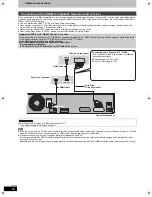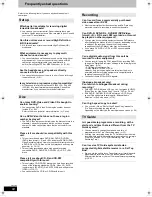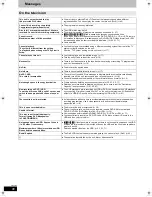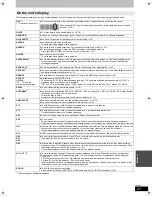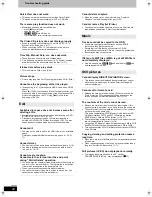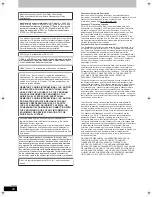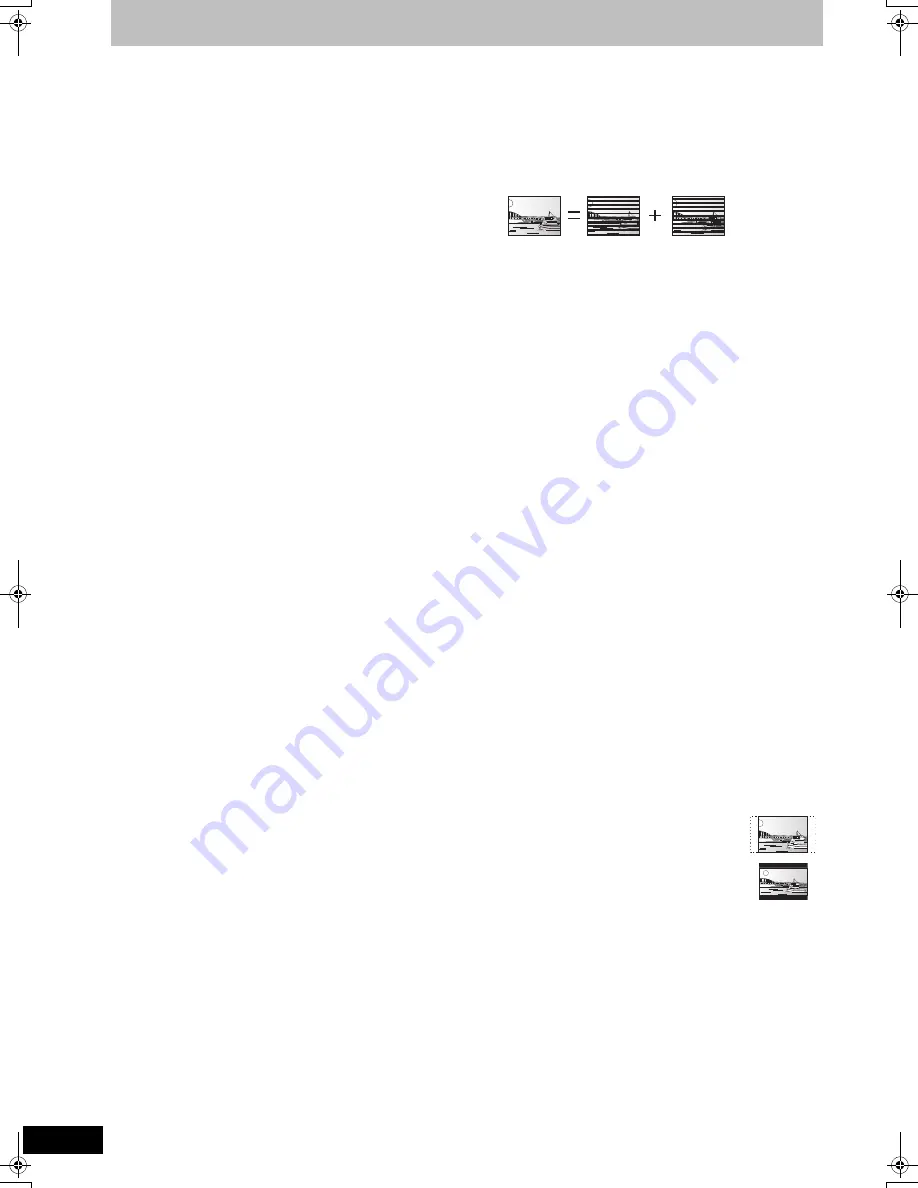
96
VQT2J46
Glossary
Bitstream
This is the digital form of multi-channel audio data (e.g., 5.1 channel)
before it is decoded into its various channels.
CPRM (Content Protection for Recordable Media)
CPRM is technology used to protect broadcasts that are allowed to
be recorded only once. Such broadcasts can be recorded only with
CPRM compatible recorders and discs.
Decoder
A decoder restores the coded audio signals on DVDs to normal. This
is called decoding.
Deep Colour
This unit incorporates HDMI
TM
(V.1.3a with Deep Colour) technology
that can reproduce greater colour gradation (4096 steps) when
connected to a compatible TV. You can enjoy exceptionally rich,
natural-looking colours, with smooth, detailed gradation and minimal
colour banding. [A lower colour gradation (256 steps), without Deep
Colour, will be reproduced if connected to a TV which does not
support Deep Colour. The unit will automatically set appropriate
output to suit the connected TV.]
DivX
DivX is a popular media technology created by DivX, Inc. DivX
media files contain highly compressed video with high visual quality
that maintains a relatively small file size.
Dolby Digital
This is a method of coding digital signals developed by Dolby
Laboratories. Apart from stereo (2-channel) audio, these signals can
also be multi-channel audio. A large amount of audio information
can be recorded on one disc using this method.
When recording on this unit Dolby Digital (2 channel) is the default
audio.
Down-mixing
This is the process of remixing the multi-channel audio found on
some discs into two channels. It is useful when you want to listen to
the 5.1-channel audio recorded on DVDs through your television’s
speakers. Some discs prohibit down-mixing and this unit can then
only output the front two channels.
Drive
In the instance of this unit, this refers to the hard disk (HDD), disc
(DVD), video cassette (VHS) and SD card (SD). These perform the
reading and writing of data.
DTS (Digital Theater Systems)
This surround system is used in many movie theaters. There is good
separation between the channels, so realistic sound effects are
possible.
Dynamic range
Dynamic range is the difference between the lowest level of sound
that can be heard above the noise of the equipment and the highest
level of sound before distortion occurs.
Dynamic range compression means reducing the gap between the
loudest and softest sounds. This means you can listen at low
volumes but still hear dialogue clearly.
Film and video
DVD-Videos are recorded using either film or video. This unit can
determine which type has been used, then uses the most suitable
method of progressive output.
Finalise
A process that makes play of a recorded CD-R, CD-RW, DVD-R,
etc. possible on equipment that can play such media. You can
finalise DVD-R, DVD-R DL, DVD-RW (DVD-Video format), +R, +R
DL on this unit.
After finalising, the disc becomes play-only and you can no longer
record or edit. However, finalised DVD-RW can be formatted for
recording again.
Folder
This is a place on the hard disk, disc or SD card where groups of
data are stored together. In the case of this unit, it refers to the place
where still pictures (JPEG) and MPEG2 are stored.
Formatting
Formatting is the process of making media such as DVD-RAM
recordable on recording equipment.
You can format DVD-RAM, DVD-RW (only as DVD-Video format),
+RW, SD cards and the HDD or R and +R DL on this unit.
Formatting permanently deletes all contents.
Frames and fields
Frames refer to the single images that constitute the video you see
on your television. Each frame consists of two fields.
≥
A frame still shows two fields, so there may be some blurring, but
picture quality is generally better.
≥
A field still shows less picture information so it may be rougher, but
there is no blurring.
HDD (Hard disk drive)
This is a mass data storage device used in computers, etc. A disk
with a surface that has been treated with magnetic fluid is spun and
a magnetic head is brought in close proximity to facilitate the reading
and writing of large amounts of data at high speed.
HDMI (High-Definition Multimedia Interface)
Unlike conventional connections, it transmits uncompressed digital
video and audio signals on a single cable. This unit supports high-
definition video output [720p (750p), 1080i (1125i), 1080p (1125p)]
from HDMI AV OUT terminals. To enjoy high-definition video a high
definition compatible television is required.
JPEG (Joint Photographic Experts Group)
This is a system used for compressing/decoding colour still pictures.
If you select JPEG as the storage system on digital cameras, etc.,
the data will be compressed to 1/10–1/100 of its original size. The
benefit of JPEG is less deterioration in picture quality considering
the degree of compression.
LPCM (Linear PCM)
These are uncompressed digital signals, similar to those found on
CDs.
MPEG2 (Moving Picture Experts Group)
A standard for efficiently compressing and expanding colour video.
MPEG2 is a compression standard used for DVD and satellite based
digital broadcasting. This unit records programmes using MPEG2.
SD Video files shot with a Panasonic SD video camera, etc. can be
copied to the HDD or a DVD-RAM disc.
MP3 (MPEG Audio Layer 3)
An audio compression method that compresses audio to
approximately one tenth of its size without any considerable loss of
audio quality.
Pan&Scan/Letterbox
In general, DVD-Video are produced with the intention that they be
viewed on a widescreen television (16:9 aspect ratio), so images
often don’t fit regular (4:3 aspect ratio) televisions. Two styles of
picture, “Pan & Scan” and “Letterbox”, deal with this problem.
Playback control (PBC)
If a Video CD has playback control, you can select scenes and
information with menus.
(This unit is compatible with version 2.0 and 1.1.)
Film:
Recorded at 25 frames per second (PAL discs) or 24
frames per second (NTSC discs). (NTSC discs
recorded at 30 frames per second as well.)
Generally appropriate for motion picture films.
Video:
Recorded at 25 frames/50 fields per second (PAL discs)
or 30 frames/60 fields per second (NTSC discs).
Generally appropriate for TV drama programmes or
animation.
Pan & Scan:
The sides are cut off so the picture
fills the screen.
Letterbox:
Black bands appear at the top and
bottom of the picture so the picture
itself appears in an aspect ratio of
16:9.
Frame
Field
Field
DMR-EX99VEG-VQT2J46_eng.book 96 ページ 2010年1月14日 木曜日 午前10時31分

